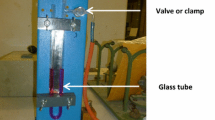Abstract
Cork granules are produced as by-products and waste by the cork processing industries that make ‘bottle stoppers’ as a main product. These granules are of low density and could be used as lightweight aggregates for making concrete. This paper describes an investigation carried out to assess the compatibility of cork granules with cement for the manufacture of lightweight cementitious composites. Five different grades of cork granules varying in terms of size and density were investigated. The effects of extractives, particle size and density of the cork granules were studied. The results indicate that these parameters affect cement hydration in a complex way. At lower concentrations of cork (10%), only the extractives have an influence on hydration behaviour. At higher cork concentrations (20% and 30%), however, particle size and density also affect the compatibility. Nevertheless, cork granules are found to be compatible with cement.
Zusammenfassung
Korkgranulat entsteht in der korkverarbeitenden Industrie als Neben- und Abfallprodukt bei der Herstellung von Flaschenkorken. Korkgranulat hat eine geringe Dichte und könnte als Leichtzuschlagstoff für die Herstellung von Beton verwendet werden. In diesem Artikel werden die Ergebnisse einer Untersuchung zur Beurteilung der Kompatibilität von Korkgranulat und Zement zur Herstellung von zementgebundenen Verbundwerkstoffen vorgestellt. Unter Verwendung von fünf Korkgranulatarten unterschiedlicher Grösse und Dichte wurde die Wirkung von Extraktstoffen, der Partikelgrösse und der Dichte untersucht. Es zeigte sich, dass sich diese Parameter in komplexer Weise auf die Zementhydration auswirken. Bei geringem Korkanteil (10%) wirken sich nur die Extraktstoffe auf das Hydrationsverhalten aus. Bei höheren Korkanteilen (20 und 30%) beeinflussen jedoch auch die Partikelgrösse und die Dichte die Kompatibilität. Insgesamt gesehen erwies sich Korkgranulat als mit Zement kompatibel.
Similar content being viewed by others

References
Aggarwal LK, Singh J (1990) Effect of plant fibre extractives on properties of cement. Cement Concrete Compos 12:103–108
Ahn WY, Moslemi AA (1980) SEM examination of wood-Portland cement bonds. J Wood Sci 13(2):77–82
Aziz MA, Murphy CK, Ramaswamy SD (1979) Lightweight concrete using cork granules. Int J Cement Compos Lightweight Concrete 1:29–33
Cordeiro N, Belgacem MN, Gandini A, Pascoal Neto C (1999) Urethanes and polyurethanes from suberin 2: synthesis and characterisation. Ind Crop Prod 10:1–10
Corticeira Amorim-Industria SA (2002) Cork in the construction industry. Engineers Today (available at: http://www.ingenieure-heute.de/e0101.pdf accessed on 14.03.2002)
Demirbas A, Aslan A (1998) Effects of ground hazelnut shell, wood and tea waste on the mechanical properties of cement. Cement Concrete Res 28(8):1101–1104
Ferrigno TH (1987) Principles of filler selection and use. In: Katz HS, Mileswki JV (eds) Handbook of Fillers for Plastic. Van Nostrand Reinhold, New York, pp 8–61
Freiesleben Hansen F, Pedersen J (1977) Maturity computer for controlled curing and hardening of concrete. Nordisk Betong 1:19–34
Gibson LJ, Ashby MF (1999) Cellular solids: structure and properties, 2nd ed. (Paperback). Cambridge University Press, Cambridge, pp 453–467
Hachmi M, Moslemi AA, Campbell AG (1990) A new technique to classify the compatibility of wood with cement. Wood Sci Technol 24(4):345–354
Hernandez-Olivares F, Bollati MR, Del Rio M, Parga-Landa B (1999) Development cork-gypsum composites for building applications. Const Build Mater 13:179–186
Holm TA (1994) Lightweight concrete and aggregates. 48. In: STP 169C. American Society for Testing of Materials, Philadelphia, pp 522–532
Hong Z, Lee AWC (1986) Compressive strength of cylindrical samples as an indicator of wood-cement compatibility. For Prod J 36(11):87–90
Karade SR (2003) An Investigation of Cork Cement Composites. Doctoral Thesis, Brunel University (UK)
Karade SR, Irle M, Maher K (2001) Physico-chemical aspects of the use of cork in cementitious composites. In: Proc. of the Fifth International Conference on the Development of Wood Science, Wood Technology and Forestry. 5th–7th September, Ljubljana (Slovenia), pp 97–106
Karade SR, Irle M, Maher K, Caldiera F (2002) Cork granules as lightweight aggregate. In: Dhir RK, Dyer TD, Halliday JE (eds) Sustainable concrete construction. Thomas Telford, London, pp 253–262
Karade SR, Irle M, Maher K (2003) Assessment of wood-cement compatibility: A new approach. Holzforschung 57:672–680
McIlveen-Wright DR, Williams BC, McMullan JT, Evans RH, Gulyurtlu I (2000) Some energy and waste management options for cork processing plant. Environ Waste Manage 3(4):189–200
Moslemi AA (ed) (1989) Fibre and Particleboards Bonded with Inorganic Binders. For Prod Res Soc, Madison, Wisconsin
Moslemi AA (ed) (1991) Inorganic-Bonded Wood and Fibre Composite Materials. For Prod Res Soc, Madison, Wisconsin
Moslemi AA (ed) (1993) Inorganic-Bonded Wood and Fibre Composite Materials, vol. 3. For Prod Res Soc, Madison, Wisconsin
Moslemi AA (ed) (1995) Inorganic-Bonded Wood and Fibre Composite Materials, vol. 4. For Prod Soc, Spokane
Neville AM (1995) Properties of concrete. 4th ed. Prentice Hall, Pearson Education Ltd, Harlow, Essex, UK
Oliveira MAD, Oliveira LD (1991) The cork. Groupo Amorim
Pereira H (1988) Chemical composition and variability of cork from Quercus suber L. Wood Sci Technol 22:211–218
Pereira H, Melo B, Pinto R (1994) Yield and quality in the production of cork stoppers. Holz Roh- Werkst 52:211–214
RILEM TCE 1 (1997) Adiabatic and semi-adiabatic calorimetry to determine the temperature increase in concrete due to hydration heat of the cement. Mater Struct 30:451–457
Sandermann W, Kohler R (1964) Studies on mineral-bonded wood materials. IV. A short test of the aptitudes of woods for cement-bonded materials. Holzforschung 18:53–59
Swamy RN (ed) (1988) Natural Fibre Reinforced Cement and Concrete. Blackie and Sons Ltd., Glasgow
T 207 om-93 (1993) Water Solubility of Wood and Pulp. TAPPI
T 211 om-93 (1993) Ash in Wood, Pulp, Paper and Paperboard: Combustion at 525 °C. TAPPI
Weatherwax RC, Tarkow H (1964) Effect of wood on setting of Portland cement. For Prod J 14(12):567–570
Author information
Authors and Affiliations
Corresponding author
Rights and permissions
About this article
Cite this article
Karade, S., Irle, M. & Maher, K. Influence of granule properties and concentration on cork-cement compatibility. Holz Roh Werkst 64, 281–286 (2006). https://doi.org/10.1007/s00107-006-0103-2
Published:
Issue Date:
DOI: https://doi.org/10.1007/s00107-006-0103-2



